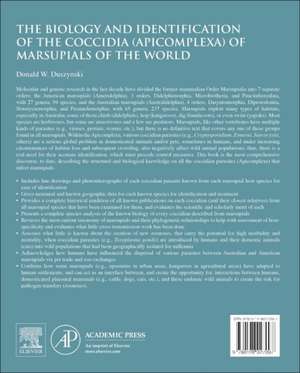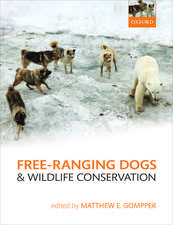The Biology and Identification of the Coccidia (Apicomplexa) of Marsupials of the World
Autor Donald W. Duszynskien Limba Engleză Hardback – 5 noi 2015
Marsupials, like other vertebrate animals have many different kinds of parasites (e.g. viruses, protozoa, worms, arthropods, etc.), but there is no definitive text that covers any one of these groups found in all marsupials.
Coccidiosis is a serious global problem in most domesticated animals, and under increasing circumstances of loss of habitat and crowding, may also affect some wild animal populations, thus, there is a real need for their identification and control.
- Offers line drawings and photomicrograph of each parasite from each hosts species, including methods of identification and treatment
- Presents a complete historical rendition of all known publications on coccidia (and their closest relatives) from all marsupials species on Earth, and evaluates the scientific and scholarly merit of each
- Provides a complete species analysis of the known biology of every coccidian described from marsupials
- Reviews the most current taxonomy of marsupials and their phylogenetic relationships needed to help assess host-specificity and evaluate what little cross-transmission work is available
Preț: 430.52 lei
Preț vechi: 533.88 lei
-19% Nou
Puncte Express: 646
Preț estimativ în valută:
82.41€ • 89.54$ • 69.27£
82.41€ • 89.54$ • 69.27£
Carte tipărită la comandă
Livrare economică 14-28 aprilie
Preluare comenzi: 021 569.72.76
Specificații
ISBN-13: 9780128027097
ISBN-10: 0128027096
Pagini: 254
Dimensiuni: 191 x 235 x 17 mm
Greutate: 0.72 kg
Editura: ELSEVIER SCIENCE
ISBN-10: 0128027096
Pagini: 254
Dimensiuni: 191 x 235 x 17 mm
Greutate: 0.72 kg
Editura: ELSEVIER SCIENCE
Cuprins
I. Introduction & overview of marsupials of the world and the parasitesII. Order DidelphomorphiaIII. Order DasyuromorphiaIV. Order DiprotodontiaV. Orders Pacituberculata, Microbiotheria, Notoryctemorphia, PermelmorphiaVI. Cryptosporidium, Sarcocystis, and Toxoplasma in marsupialsVII. Species inquirendaeVIII. Discussion and summary (Host specificity, pathology, epidemiology, treatment and controlIX. Literature Cited







